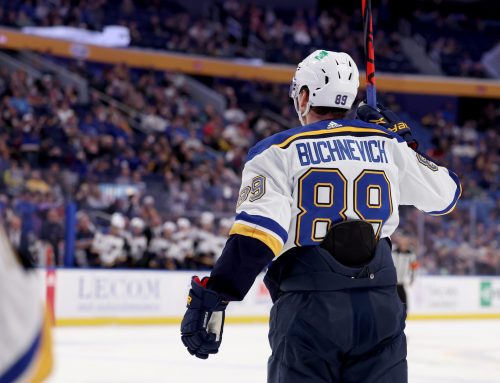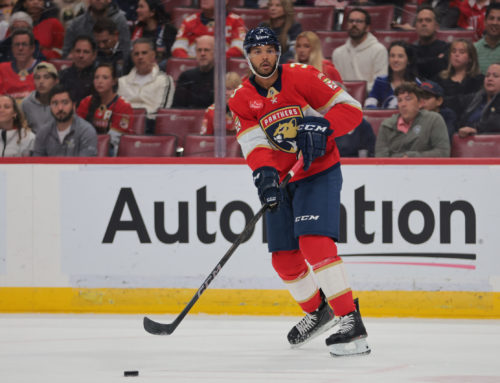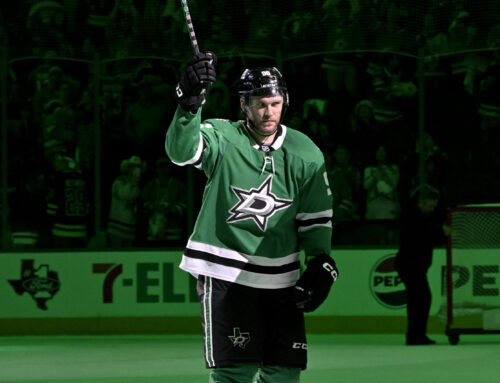
Some disappointments from 2015-2016, World Cup tracking, Radim Vrbata, and more
****
Over the summer, I’ve pointed out a few players that may come at good value next year because they disappointed fantasy owners last year. There is no time when a player’s value will be higher than just after they burned a fantasy owners provided, of course, that it is actually a good player, and not a one-year wonder fluke.
Some of the players I have mentioned recently include Ondrej Palat and Tyler Johnson. There are others, of course, that should come in at a depressed ADP just because of their performance last season. They’re still good players, though, and the depressed ADP presents a value opportunity.
The 55 points that Voracek put up last year were clearly a disappointment to fantasy owners, considering he was probably drafted in the second round at some point. The thing is, that mark is actually the second-highest of his career, and the point/game mark of 0.75 was almost identical to his 2013-2014 season, when he posted a 0.76. So, disappointment relative to ADP? Yes. Disappointment relative to what he’s done for the majority of his career? That’s up for debate.
Voracek’s biggest problem was goal scoring, as his 11 goals was considerably lower than what he managed in the three previous seasons (22, 23, 22 in 48 games). A big reason for that was his power play goal scoring, where he tallied just one goal, after posting totals of 11, 8, and 8 (in 48 games) the previous three seasons. If he scores eight power play goals last year, he manages 62 points, and is likely seen much less as a disappointment.
This is where it’s important to note that Voracek shot 1.33-percent on the power play last year. Over the previous three seasons, Voracek shot 13.54-percent. If he shoots at that three-year rate last year, on the 75 shots he landed on net, he has 10 power play goals, which would be about average for him. This is where I feel comfortable saying there is no chance that Voracek repeats a 1.33-percent shooting rate on the power play in 2016-2017.
At five-on-five, Voracek’s shooting rate in 2015-2016 was 6.72-percent, whereas that was 9.44-percent over the previous three seasons. So if he shoots is career average last year, he scores 11 five-on-five goals instead of eight. In sum, if Voracek shoots his three-year rate at both five-on-five, and on the power play, he adds 12 goals to his total. That means Voracek would have 67 points in 73 games, or something close to what fantasy owners would expect.
Voracek should see a big turnaround next year. He missed as many games in 2015-2016 as he did from 2008-2015 combined. With the shooting rates normalizing, and a return to a full season, Voracek is in the realm of 70 points. His ADP should be at least a couple rounds lower than it was last year, and that’s music to the ears of fantasy owners that are paying attention.
Poor defending teams can kill a goalie’s fantasy value. Consider this: Semyon Varlamov’s save percentage from 2013-2015 was .925. Cory Schneider’s save percentage over that span was .924. And yet, Varlamov’s goals against average was over one-third of a goal higher (2.48 to 2.14) than Schneider’s. Because GAA is a function of minutes, and not shots, whether you give up three goals on 50 shots faced, or 30 shots faced, is irrelevant. In a 60-minute game, both amount to a 3.00 GAA, even though the goalie that saved 47 shots clearly had the better game than the one that saved 27.
Whatever is said at Patrick Roy as a coach, this much is certain: his teams couldn’t defend a lollipop from a six-year-old. From 2013-2016, only Ottawa, Buffalo, and Toronto gave up more shots per minute than the Avalanche, which is what killed a good chunk of Varlamov’s fantasy value. Even when Varlamov had a .927 save percentage in 2013-2014, his GAA was the same as Kari Lehtonen’s, who had a .919 save percentage.
I am optimistic for Varlamov. Over the last three seasons, his overall save percentage of .921 is the same as Henrik Lundqvist, and Roberto Luongo. Varlamov is also just 28 years old. Hopefully, whichever coach the Avalanche hire can actually institute some defensive systems. This is a guy who can produce a .920 season, and with a team that doesn’t get lit up on the shot clock like it’s a Globetrotters/Generals game, he could be solid across the board. With how poor he fared last year, he should be a draft day value.
****
I saw an interesting article come across my timeline yesterday from the Montreal Canadiens blog at SBNation, Eyes on the Prize. It discusses Andrei Markov’s positioning among the legends of the Montreal Canadiens. Before your eyes roll completely out of your head, read the article. It is very illuminating, and kind of changed how I viewed him as well.
At this point, it’s hard to believe that Markov has been in a Habs uniform since the year 2000 (insert Silverchair song here). It is an era when players almost always do not last longer than a decade with the same franchise. It’s especially impressive when you consider the devastating knee injuries that Markov suffered once he cruised by the 30-year-old mark.
Again, I understand the hesitation to place Markov among the pantheon of Montreal greats, particularly the defencemen. When you look at his production, and longevity, though, the hesitation doesn’t take long to grow into acceptance.
****
Vrbata said he talked to Dave Tippett before signing and Tip indicated hs role would be similar to before, maybe playing with Hanzal.
— Craig Morgan (@craigsmorgan) August 16, 2016
📢 advertisement:
Readers can peruse Neil Parker’s take on the Vrbata signing here.
One of the few remaining dominos fell earlier this week as Radim Vrbata signed with the Arizona Coyotes. His deal is officially one-year for $1-million, but it is an incentive-laden contract that could see the AAV roughly triple. That is of little consequence to the Coyotes, though, as Tobias Rieder is the lone remaining RFA to be signed, and the Coyotes are several million under the cap as it is (with more money to come off once the season start).
As a small aside, this is a curious landing for the twice-former Coyote. Undeniably, it was a bad year last year for Vrbata, who posted his lowest goal total (13) in a season where he’s played at least 50 games since before the 2005 lockout. He was fifth on the Canucks in goal scoring, and had he played 75-80 games, he could have easily finished third. Not to mention the Canucks were just poor overall as a team, as both Daniel and Henrik Sedin posted their lowest point totals for a season where they played at least 75 games since the 2005 lockout as well. Almost no one was immune to how bad the team was. I find it hard to believe there was no Cup contender out there who couldn’t use Vrbata on their third line, and on the power play. But I digress.
Whether or not fantasy owners believe in Vrbata next year depends solely one whether or not fantasy owners believe he’s in full decline. Vrbata’s shot/game rate of 3.16 was over the 3.00 mark for the seventh consecutive season; his shots/60 minute rate at five-on-five was much in line with what he’s done the last several seasons; his goals/60 minutes at five-on-five was low (0.62), but not egregiously lower than his three-year mark prior to last season (0.77). The only things that were egregiously low were his on-ice shooting percentage, or the rate at which his teammates scored at five-on-five when he was on the ice, which was a Behind The Net-era low for him at 5.25-percent, and his power play productions, as his nine PP points were less than half he had in each of the previous two seasons (23, 21).
In that sense, if Vrbata gets top-six minutes with Hanzal, as indicated above, and significant power play time, it seems 20 goals and 50 points are within reach. This is still a guy who shoots a lot, and drives the play for his teammates. Again, it all depends on whether it is believed the decline has started. I’m willing to give him the benefit of the doubt for fantasy purposes, especially considering his ADP will be next-to-nothing this year.
****
The NHL will have player/puck tracking available for the World Cup of Hockey.
They'll track puck and player speed, distance between all players etc. Will be used during broadcasts.
— James Mirtle (@mirtle) August 17, 2016
Ok.
First, let’s re-visit the fact that SAP has completely bungled the NHL’s “advanced stats” rollout on their site. For a refresher on how poorly this has gone, please visit Travis Yost’s blog where he outlines their problems. In a word: awful.
For that reason, pardon my skepticism that this will go well. Undeniably, player tracking is the next meta of statistics, much like the NBA with SportVu. Proper spacing, angling, and other areas similar to this are currently being done by the naked eye, and accurate tracking can help a lot in this regard.
The obvious problem is whether or not this information will be accurate. SAP does not have a good track record in this area. The secondary problem, assuming accuracy of information, is the proper application of this information.
I’m reminded of current NHL coverage that shows us a player’s speed. “Phil Kessel was cruising along at 30 kilometres an hour.” Ok, great. In reference to what? Is that fast compared to other players? Fast against defencemen, or forwards? Is it even fast for him? Just spitting out numbers without context doesn’t help. In fact, it probably hurts, as these numbers just convolute the understanding of hockey when a good chunk of analysts (and fans) still can’t understand why outshooting the opponent is a good thing. So if a defenceman is giving a 1.6 metre gap at the blue line, will the analysts know if that’s good? What’s a good point of reference? Does that gap change from player to player?
So yes, without knowing that a company with a poor record of keeping accurate statistics will actually be able to provide accurate tracking technology, and without knowing the presenters giving this information to the public have any idea how to interpret/convey this information, I’m skeptical this is a significant move, at least in the short-term. Information is good, knowledge is better, and the gap between the two is a chasm the NHL, and many of its affiliates, have yet to bridge.
*Stats from Hockey Reference and Hockey Analysis. Cap information from Cap Friendly.
11 Comments
Leave A Comment
You must be logged in to post a comment.





 TOR
TOR FLA
FLA VGK
VGK EDM
EDM DAL
DAL MIN
MIN WPG
WPG CBJ
CBJ CAR
CAR N.J
N.J

Another great ramblings with many interesting thoughts. I would like to discuss this part of it a little bit more.
“Because GAA is a function of minutes, and not shots, whether you give up three goals on 50 shots faced, or 30 shots faced, is irrelevant. In a 60-minute game, both amount to a 3.00 GAA, even though the goalie that saved 47 shots clearly had the better game than the one that saved 27.”
I disagree with your thinking that the goalie who made 47 saves was better than the goalie that made 27. Part of the responsibility of a goalie is to limit 2nd shot opportunities (ie rebounds), the goalie who made 47 saves probably did a much worse job of that then the goalie who made 27 saves.
I just cannot agree with this statement. Allowing more rebounds can’t be the reason for 20 more shots in a game. The goalie with 0.940 surely had a better game than the one with 0.900
Who won is the better question…
I smell a new category of goalie stats! Some fancy factor that takes SV%, GAA, and rebounds given up.
Pretty sure this exists if you look for it. People have taken the number of shots a goalie faces from each area of the ice, and compared their actual save percentage versus the league average save percentage from shots in each area. Google “adjusted save percentage” I think.
The other thing that exists is what Rob Vollman does with his “Quality Starts” metric, which combines takes shots against and goals against to give you an idea of what was a good game and what was a bad game for a goalie.
Thanks for reading!
In theory, yes, the goalie could give up 20 extra shots in rebounds, but I feel comfortable in saying that happens with much less frequency than a poor defensive team just giving up a lot of shots. Also, it would be part of the goaltender’s team’s duties to clear out players/rebounds, so if giving up a ton of rebound shots is indeed the case, then the team in front of the goalie hasn’t done a good job either.
Shouldn’t we consider the concept of “quality” of the shots too? There has to be a major difference between facing a shot from P.Kane on a breakaway and say J.Kindl shooting from the point… Tip in, deflections, location of shots is what makes a difference, not the total shots. Any goalie or defense corp would be dead laughing facing 30 shots from the blue line, even 40. Shoot all you want as long as we don’t let you take shots from the “hot” zones. Now my question is, how can we get such data??
SAP = Stupid Ass Program. Ive had the misfortune of dealing with this nightmare the last 3 years. good in theory, but an absolute clusterfudge to actually use.
SAP is a nightmare.
SAP is great in a payroll & organizational planning environment. Not sure what you’re using it for.
Le sigh.
Another person weighs in on the ‘Benning is a crap GM’ sweepstakes: “I find it hard to believe there was no Cup contender out there who couldn’t use Vrbata on their third line, and on the power play. But I digress.”
There were GMs who were interested; that wasn’t the issue. Can I offer you another quote, this time from Vrbs? “I don’t think I handcuffed them, but I knew what I was doing,” Vrbata said this week. “I could have given a lot more (options) and I would have moved. If I wanted to get traded, I would have been traded.” – from an interview with Botchford, April 13th’s Vancouver Sun (not related to the eastern newspaper chain).
I can’t blame the guy for using his partial NTC to effectively block a trade; his wife was 8 months pregnant, and that is why you sign a NTC for–to block trades you don’t want to happen. If I was in his shoes, I’d probably block a trade, too; I suspect that the author of this piece would as well, if we were both given the opportunity to do so.
But unless you want to blame JB for not trading Vrbata in July 2015 (which is a perfectly reasonable criticism, especially if you thought the 3rd in the conference performance of 2014-15 was smoke & mirrors–and one that Vrbs seems to hold himself in the above interview), then you’re being (at the most charitable reading) unreasonable. After January, Vrbata was not going to be traded. He made that decision; not the Canucks, and not any other GMs.